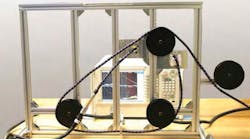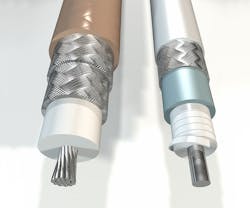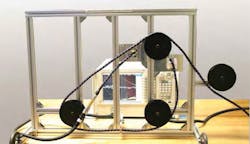Coaxial cables and connectors are important components in any electronic system, but in mission-critical systems, lives can depend on them and the signal information they carry. While they can be thought simply as the means to get signals from one point to another, a poor fit or undue stress on a coaxial interconnection can result in system performance degradation. Understanding how different coaxial cables and connectors work can not only help improve their parts in a system, but in the test equipment used to evaluate the system.
Cables and connectors have come a long way in terms of frequency, tracking the movement upward into the millimeter-wave (mmWave) range as with many other passive components. Broadband cables and connectors were once considered for use from dc to 18 GHz, but such cable assemblies are now considered standard equipment in defense electronic systems.
Connectors are starting points for moving signals from one component to the next. Improving capabilities to machine the shrinking interface dimensions of coaxial connectors has made it possible to reach well into the mmWave frequency range. they have progressed steadily upward in frequency since the introduction of the 2.92-mm 40-GHz K connector in 1985, followed by the 50-GHz, 2.4-mm connector; the 65-GHz, 1.85-mm connector; and the 1.00-mm, 110-GHz connector. Most recently, Anritsu introduced a D-band connector with 0.8-mm interface dimensions for test applications to 110 GHz.
Development of semirigid and flexible coaxial cables typically follows the introduction of smaller coaxial connectors. For system designers at mmWave frequencies, the question is often whether available coaxial cable assemblies can match the electrical performance of the waveguide currently used at those frequencies, especially in terms of insertion loss and power-handling capabilities.
Cables can also exhibit performance differences over time that typically do not occur with rectangular waveguide, such as changes in amplitude and phase due to cable flexure (in flexible cables). Such characteristics must be considered when specifying coaxial cables and connectors for military and aerospace system designs.
Cable suppliers are constantly seeking to improve the performance of their coaxial cables. Take the recent introduction of GORE Optimized RG400 Coaxial Cable by WL Gore, which would serve a replacement for the literally miles of low-frequency RG400 flexible cables in military aircraft. The upgraded version (Fig. 1) of the cable is 60% lighter and 30% smaller than the legacy cable, while providing enhanced performance through 3 GHz.
1. RF400 coaxial cables, widely used in defense electronics systems, were recently upgraded into the GORE Optimized RG400 Coaxial Cable that’s smaller and lighter, and has better performance, than the original. (Courtesy of W. L. Gore & Associates)
The new cable has an outer diameter of 3.5 mm and weight of 26 g/m, for significant savings in space and weight in aircraft interconnections. The insertion loss is extremely low, only 0.17 dB/m at 200 MHz, 0.25 dB/m at 1000 MHz, and 0.80 dB/m at 3000 MHz, while the power-handling capability is quite high, 1100 W at 50 MHz, 450 W at 400 MHz, and 150 W at 3 GHz. The 50-Ω cables exhibit a maximum velocity of propagation of 75% and an operating temperature range of −65 to +200°C. Environmental protection is achieved with a fluorinated ethylene propylene (FEP) outer jacket
Perhaps of most importance when it comes to the long-term reliability of aircraft high-frequency interconnections, the optimized RG400 cables can be bent into tight spaces: They have a maximum dynamic bend radius of 100 mm (3.94 in.) for repeatable bends without damage and a maximum static bend radius of 35 mm (1.38 in.) for permanent bends in system installations. The cables, which meet or exceed MIL-C-7 electrical requirements, can be terminated with a variety of coaxial connectors, including SMA, BNC, and Type N connectors. The outer jacket of the cables is UV-laser printable for identification purposes.
Keeping in Phase
Due to the use of signal phase as a key parameter in many defense electronic systems, phase stability is an important characteristic for high-frequency coaxial cables. Phase tracking is yet another phase-based parameter for cables, to evaluate how closely cables of the same length maintain the same phase at the same frequency during changes in temperature.
Coaxial cables can be subjected to a great deal of bending during installation, use, and maintenance, and are subject to changes in phase as a result of the bending. This may degrade the performance of phased-array radars and other systems depending on stable phase.
For multiple-channel installations where different channels are compared, the stability of the electrical cable length with flexure, temperature, vibration, and other environmental conditions is another important performance parameter for defense electronics systems. WL Gore employs its proprietary expanded-polytetrafluoroethylene (ePTFE) cable dielectric material as a key component in its coaxial cables to maintain stable phase and electrical length under changing environmental conditions.
Installation within aircraft systems can take its toll on coaxial cable assemblies, with all of the routing, bending, and flexing that the cables go through. GORE-FLIGHT 6 Series and Standard Series microwave cable assemblies from Gore were developed to withstand such punishment, for applications from dc to 18 GHz.
Suitable for use in missile warning systems, airborne electronic-countermeasures (ECM) systems, and radar systems, these 50-Ω cables have low loss, with typical insertion loss of 0.198 dB/ft. at 18 GHz for 6 Series cables and 0.342 dB/ft. for Standard Series cables. A velocity of propagation of 86% ensures minimal signal delays through the cables. The cables undergo extensive testing, including wear testing to simulate the abrasions from aircraft installations (Fig. 2), as a way of understanding how they will perform under realistic operating conditions.
2. Many cable suppliers subject their cable and connector assemblies to rigorous testing to more closely simulate real-world conditions, such as this test system that duplicates the installation of coaxial cables into airframes. (Courtesy of W. L. Gore & Associates)
Dealing with Power
For many EW and radar systems, power-handling capability is an important performance parameter. It’s an area where coaxial cables and connectors usually fall short compared to the capabilities of waveguide flanges and transmission lines. RG400 50-Ω coaxial cables from Winchester Interconnect, for example, are formed with silver-plated copper-clad steel center conductor and PTFE dielectric to achieve a maximum cutoff frequency of 12.4 GHz. They handle as much as 1470 W signal power at 100 MHz, 430 W at 1 GHz, and 100 W at 11 GHz, and offer a minimum bend radius of 1 in. with a velocity of propagation of 69.5%.
For even higher-power applications, the same company’s line of Tru-Win high-power coaxial cables provide power-handling capabilities in the kilowatt range at microwave frequencies (with the proper coaxial connectors). For example, the TRU-350 coaxial cable is rated for maximum power of 22.5 kW at 50 MHz, 4 kW at 1 GHz, and 8.88 kW at 18 GHz. The firm supports its cables with many M39012-qualified coaxial connectors, including for type C, N, TNC, BNC, and SMA interfaces.
Some firms, such as Mini-Circuits, simplify the task of specifying coaxial cable assemblies for system or test applications through 50 GHz by providing an online “cable creator” type tool. Visitors can select a type of cable (flexible, semirigid, armored), its length, the types of input and output connectors, and the connector gender (male or female). A number of companies, such as Pasternack Enterprises, offer similar tools, such as Pasternack’s “The Cable Creator,” which is backed by search engines and filters for custom cable creation services and a listing of test services through 65 GHz.
For military and aerospace purposes, many suppliers offer phase-stable versions of cables with low loss and reasonable power-handling capabilities. Using their online tools, cable assemblies can be ordered with a choice of connectors and at desired lengths, in many cases for shipment by the manufacturer the same day.



